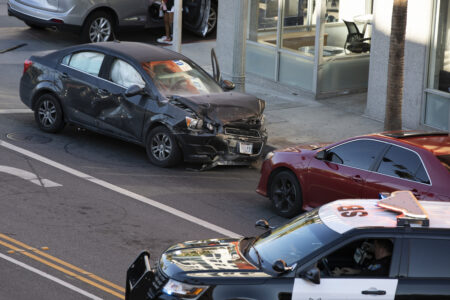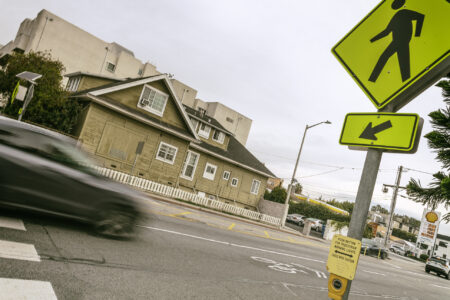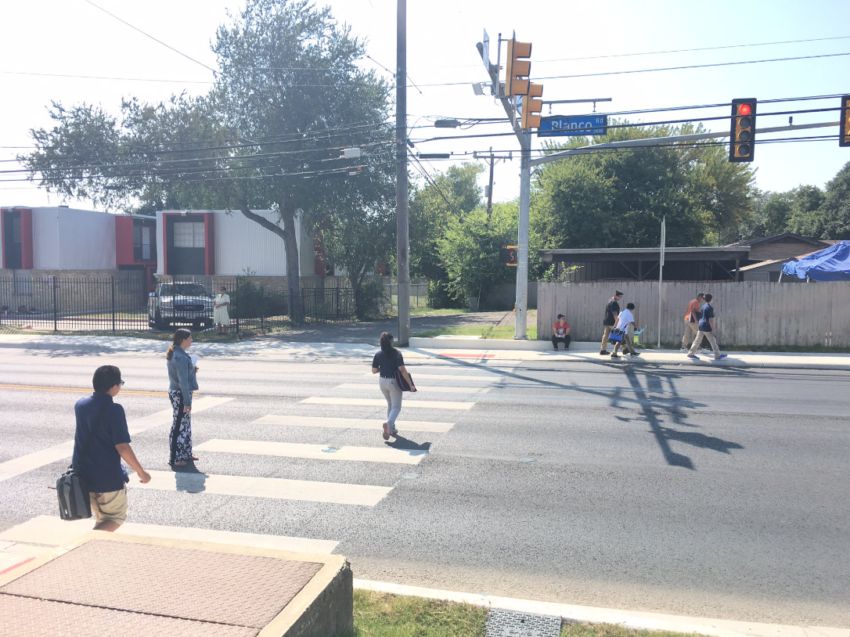
Share On Social!
A pedestrian is killed by a motor vehicle once a week, on average, in San Antonio.
In fact, 219 pedestrians died and 607 were severely injured in nearly 4,000 pedestrian-vehicle collisions from 2011-2015 on San Antonio roadways. That’s a worse rate than Austin, Houston, Los Angeles, and many other cities.
It’s even worse in San Antonio’s lower-income areas.
In these areas, communities are designed for tires and steel, rather than people. When people don’t feel safe to walk for health, recreation, or transportation, it harms their quality of life. They don’t have an equitable chance to live healthier lives.
San Antonio leaders are working to create safer streets for all.
So officials launched a Vision Zero initiative and are continuing to analyze geographical data to identifying locations where pedestrian safety efforts may have the greatest impact.
Loss of Pedestrian Life is Not Acceptable
Unsafe streets are common in many cities, especially in Latino-majority areas.
Latinos make up 16.9% of the nationwide population, yet account for 21.5% of pedestrian deaths in collisions, according to Dangerous by Design 2016. Serious injuries are also a concern. For each fatality, an estimated 23 were treated in an emergency department.
The National Physical Activity Plan calls for a prioritization of resources and comprehensive transportation safety programs to improve safety in low-income communities disproportionately affected by higher rates of bicycle and pedestrian deaths and injuries.
Loss of pedestrian life and injuries are not an acceptable price to pay for mobility.
That’s the founding belief behind Vision Zero road policies.
Vision Zero, which began in Sweden in the 1990s, posits that pedestrian deaths and injuries from vehicle collisions are not inevitable and can be reduced through better roadway design, safer pedestrian infrastructure, improved technology, and equitable policies.
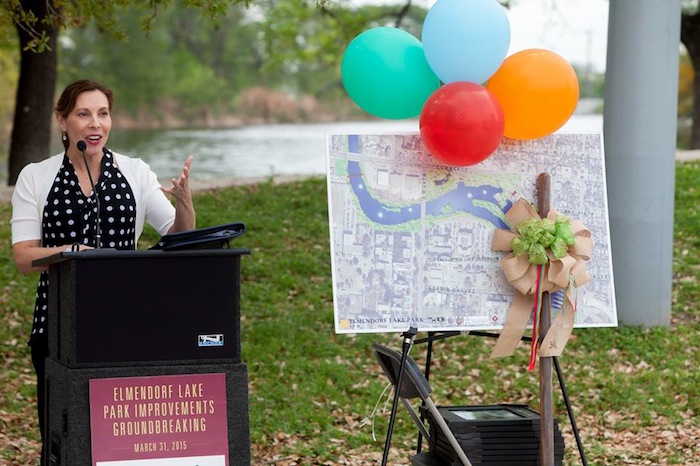
One example is reducing traffic speed. Speed is the single-biggest predictor in whether a collision results in death.
The Vision Zero Network brought the goal of eliminating all traffic deaths and serious injuries to the U.S. in 2014. Cities have steadily joined the network. See how Vision Zero works.
At its core, Vision Zero is about equity by creating safe transportation options for everyone.
San Antonio Becomes Vision Zero City
In June, 2015, City Councilwoman, Shirley Gonzales initiated a Council Consideration Request to fellow council members to develop a Vision Zero Action Plan and become a Vision Zero city.
A Vision Zero city is one that meets the following minimum criteria:
- A clear goal of eliminating traffic fatalities and severe injuries has been set.
- The Mayor has publicly, officially committed to Vision Zero.
- A Vision Zero plan or strategy is in place, or the Mayor has committed to doing so in clear time frame.
- Key city departments (including police, transportation and public health) are engaged.
“Vision Zero requires a new way of not only viewing traffic safety, but also the network of streets and the built environment that those streets serve,” Gonzales wrote in the Rivard Report.
In September, 2015, San Antonio officially launched Vision Zero under the city’s Transportation and Capital Improvements Department (TCI).
They got to work on installing pedestrian midblock crossings or Z-Crossings.
“Agencies that lead in the areas of transportation, planning, zoning, land use, and community development must all be fully engaged in developing and implementing the Vision Zero action plan,” Gonzales wrote in the Rivard Report.
TCI staff began to analyze crash data from 2011 through 2015 to determine high crash areas where Vision Zero efforts may have the greatest impact.
In September, 2016, $1 million was included in the city’s capital budget for the Vision Zero program to fund a minimum of 10 engineering studies in five high-crash areas.
In October, 2016, TCI published their Vision Zero Action Plan using five elements for a safe transportation system:
- Education: Coordinate with school districts to distribute information to area students, teachers, staff and parents.
- Encouragement: Reach 500,000 users of social media.
- Engineering: Implement 10 Vision Zero projects annually.
- Enforcement: Pursue state legislative change to establish a camera speed enforcement pilot program in school zones.
- Evaluation: Identify 20 high crash corridors and 20 high-crash intersections.
High-Crash Areas in San Antonio
In November 2017, TCI released their report on high-crash areas, know as the Severe Pedestrian Injury Areas Report.
Severe Pedestrian Injury Areas (SPIAs) are areas where two or more crashes have resulted in a severe pedestrian injury spaced no more than one-half mile apart on the same street.
Of 826 severe pedestrian injury crashes, the TCI team identified 76 SPIAs consisting of 37 arterial roadway miles, which accounted for 274 crashes.
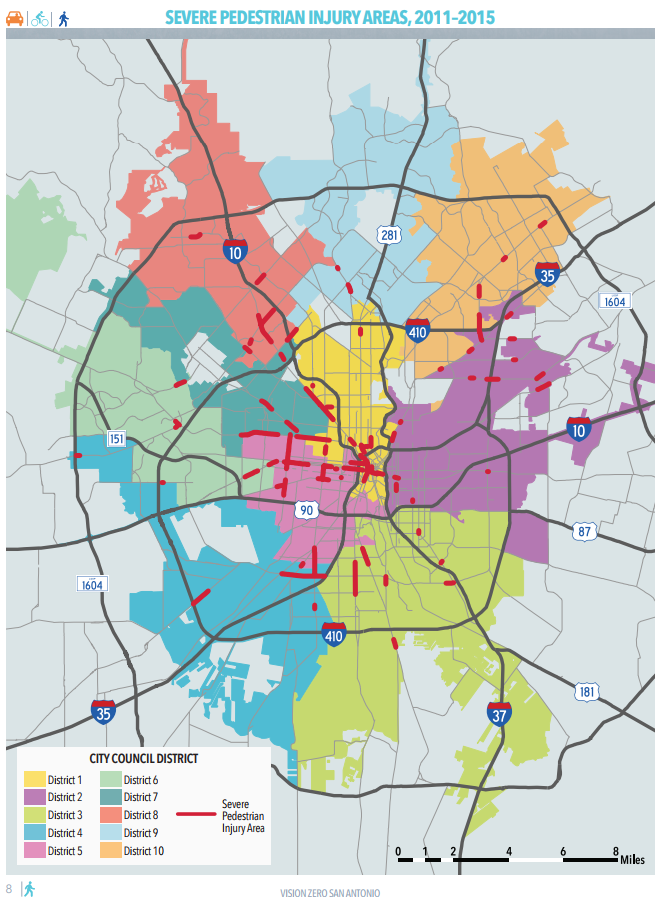
Source: COSA TCI Vision Zero
This means that 33% of the crashes occurred on just 1% of San Antonio roadways.
In a city that is already 41.4% more deadly to drive, walk or bicycle than Austin, according to Gonzales’s Council Consideration Request, these arterial roadways are even more deadly.
Pedestrian crashes are not happening randomly across San Antonio.
For example, 35 pedestrian crashes resulting in 12 severe pedestrian injuries occurred on just one 1.47 mile section of Culebra Road, an arterial roadway, from 28th to Calaveras.
Safety enhancements to this specific area could drastically reduce pedestrian fatalities and injuries, and improve residents’ health and mobility, thus quality of life.
Examples of safety enhancements include, pedestrian refuge islands, consolidating driveways, buffers between vehicles and people walking/biking, reducing the number of vehicle lanes, and lowering the speed limit are promising.
Future Vision Zero Projects
Although the SPIA report was released at the end of year, five of the 10 Vision Zero projects TCI implemented as part of the 2017 fiscal year included safety enhancements within identified SPIAs.
For example, TCI staff dedicated funding to implement a Vision Zero project at one high crash intersection within the SPIA on Culebra Rd, mentioned above.
“The City of San Antonio will be utilizing the findings from our Severe Pedestrian Injury Areas report to identify future Vision Zero infrastructure improvement projects,” said Arthut Reinhardt, TCI Assistant Director.
Additionally, SA2020, a nonprofit that reports annually on community indicators to inform and active to public to reach shared goals, added a 59th indicator to track pedestrian fatalities and injuries on their data dashboard.
Findings from the SPIA report will also be used when selecting projects through other local and state funding streams, such as the City of San Antonio’s fiscal year 2017 budget, which identified $21 million to build new sidewalks and fill in gaps throughout the sidewalk network, as well as the 2017-2022 Bond Program, which dedicated $48 million for pedestrian mobility projects.
Also within the city’s fiscal year 2017 budget, $1 million was dedicated to improving infrastructure around local schools and $1 million was dedicated to traffic calming projects.
Next steps are for TCI staff to analyze contributing factors, such as sidewalk and crosswalk availability/condition, roadway speed, lighting, and behavioral issues, such as drunk driving and hit and runs.
In order to invest in equitable pedestrian safety enhancements to reduce disparities in pedestrian fatalities and injuries, it is critical to understand where crashes occur and what contributing factors play a role.
What can you do?
Share this with transportation planners, public health leaders, and equity advocates in your city to start or support the Vision Zero movement.
UPDATE: On June 15, 2018, TCI and other partners hosted the first Vision Zero Summit, with several national speakers, including Leah Shahum of Vision Zero Network, Gabe Klein of CityFi, and Lilly O’Brien of Vision Zero Los Angeles. You can access the presentations here.
UPDATE: In August 2018, TCI launched an awareness campaign to educate the public about the importance of vehicle safety with funding from TxDOT. Additionally, San Antonio police officers began receiving additional training on Vision Zero crash reporting and will increase enforcement at dangerous intersections.
UPDATE: In September, 2018, the mayor and city council approved funding for a Pedestrian Mobility Officer in the fiscal year 2019 budget. This position will complement the current City transportation planning teams in TCI, Planning Department, and VIA and work with Metro Health.
UPDATE: In September 2018, the mayor and city council approved $19 million for sidewalks and #million for pedestrian safety initiatives, including a traffic calming program, school pedestrian safety, and Vision Zero in the fiscal year 2019 budget.
UPDATE: Watch this video from KSAT News about how complete streets are making roads safer.
By The Numbers
27
percent
of Latinos rely on public transit (compared to 14% of whites).

